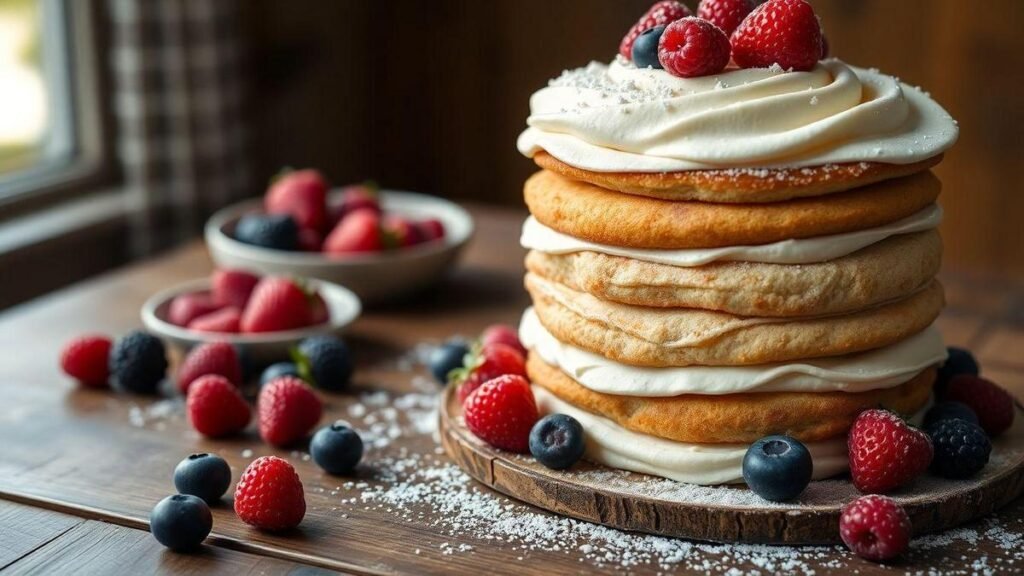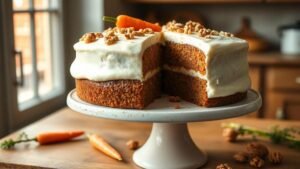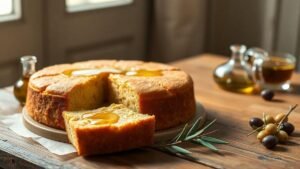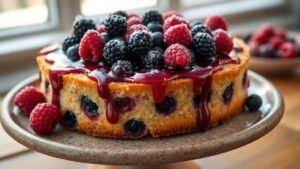I’ve always dreamed of baking the perfect cake—a fluffy cloud of sweetness that melts in your mouth. Imagine biting into a slice where each crumb is a soft hug for your taste buds! In this article, I’ll share my journey to cake nirvana. I’ll spill the secrets to creating a cake so light, it might just float away. From choosing the right flour to the importance of not peeking in the oven, I’ll cover it all. So grab your mixing bowl and get ready to bake something magical—your taste buds will thank you!
- Use cake flour for a lighter texture.
- Keep ingredients at room temperature.
- Cream butter and sugar to add air.
- Mix gently to avoid a dense cake.
- Bake at 325°F to 350°F for best results.
How to Make a Fluffy Cake That Melts in Your Mouth
When it comes to comfort food, few things can make my heart flutter quite like a fluffy cake. You know, the kind that practically dances on your tongue and whispers sweet nothings to your taste buds? Oh, yes! I’m talking about that melt-in-your-mouth goodness that can turn any ordinary day into a celebration. So, how do I whip up this delightful treat without donning a chef’s hat? Let me spill the beans!
Choose the Right Flour for a Tender Texture
First things first, I need to talk about flour. Not just any flour will do! For a truly fluffy cake, cake flour is the superstar. It has a lower protein content than all-purpose flour, which means my cake will have a finer crumb and a lighter texture. If I find myself in a pinch and only have all-purpose flour, I can simply hack it by replacing 2 tablespoons of each cup of all-purpose flour with cornstarch. Voilà! For more insights on achieving a soft cake, check out this guide on making a soft cake without a mixer.
Quick Tip: Sift the flour once or twice before adding it to the batter. This aerates the flour and helps create a fluffier cake.
Use Room Temperature Ingredients
Next, I need to ensure my ingredients are at room temperature. Eggs, butter, and milk blend together like best friends when they’re cozy and warm. Cold ingredients can cause the batter to curdle or mix unevenly, which is a total party foul for my cake’s texture. So, I make it a point to gather my ingredients and let them warm up a bit!
Cream the Butter and Sugar Properly
Now, let’s get to the fun part: creaming the butter and sugar! This is where the magic happens. By incorporating air into the batter, I’m giving my cake a lighter structure. For a delicious twist, I might also consider using applesauce instead of oil or butter, which can make the cake moist and light—find out more about that here.
Pro Tip: If I can find superfine sugar, I’m in luck! It blends more easily with the butter and creates a smoother batter. If not, I just have to whisk like my life depends on it.
Don’t Overmix the Batter
Once I start adding the dry ingredients and liquids to my creamed mixture, I have to tread lightly. Overmixing can activate the gluten in the flour, making my cake dense and rubbery. And nobody wants a cake that resembles a rubber tire! For tips on avoiding cake failures, check out these foolproof tips.
Whip Egg Whites Separately for Extra Lightness
If I’m baking a sponge or chiffon cake, I’ll separate the eggs and whip the whites separately. This trick can significantly boost the fluffiness of my cake.
Extra Tip: A pinch of cream of tartar or a few drops of lemon juice while whipping the egg whites can help stabilize them.
Don’t Skip the Leavening Agents
Let’s not forget about those leavening agents—baking powder and baking soda. They’re crucial for lift! Typically, I use 1 teaspoon of baking powder per cup of flour, but I always check my recipe just to be safe. If I find myself without baking powder, I could explore alternatives to make a cake without it, which you can learn about here.
Baking Tip: Baking my cake at the right temperature is key. The standard temp for cakes is around 325°F to 350°F (160°C to 175°C). Too hot, and my cake could turn into a dry disaster.
Use the Right Pan (And Prepare It Correctly)
Choosing a light-colored, metal pan is essential for even heat distribution. Dark pans absorb more heat, which can cause the edges of my cake to overbake. I also make sure to prepare my pan correctly—greasing and flouring it thoroughly!
Don’t Open the Oven Door Too Early
As tempting as it is to check on my cake, I must resist the urge to open the oven door too early. Doing so can cause my cake to sink, and nobody wants a sad, sunken cake.
Let the Cake Cool Properly
Once my cake is out of the oven, I let it cool properly. Cakes continue to cook slightly after being removed from the oven, and letting them cool prevents a soggy texture.
Final Touches for Maximum Softness
Want to make my cake even more luscious? I can add a simple syrup, frosting, or whipped cream to elevate it! If I’m looking for a simple glaze, I can learn how to make one here.
Conclusion
So there you have it, my fellow cake enthusiasts! I’ve revealed my secrets to achieving that heavenly, fluffy cake that floats on clouds. With the right flour, a bit of patience, and a sprinkle of love, I can whip up a cake that will impress even the toughest critics. Remember, baking is as much about the journey as it is the destination—so don’t be afraid to get a little messy along the way!
Now, if you’re ready to embark on your own baking adventure, grab that mixing bowl and channel your inner pastry wizard! And hey, if you enjoyed this cake escapade, why not check out more delightful articles at xendrie.com? Your taste buds will thank you, and who knows, you might just discover your next favorite recipe! Happy baking! 🍰
Frequently Asked Questions
What type of flour is best for fluffy cakes?
Using cake flour is the best choice. It has less protein, making your cake lighter. If you only have all-purpose flour, replace 2 tablespoons per cup with cornstarch.
Why do my ingredients need to be at room temperature?
Room temperature ingredients mix better. They create a smoother batter and help avoid clumps.
How does creaming butter and sugar help my cake?
Creaming adds air to the batter, making the cake lighter and fluffier. Use superfine sugar for a smoother mix.
What should I avoid after adding dry and wet ingredients?
Don’t mix too much! Stir gently. Overmixing can make your cake dense by activating gluten.
How can I make a sponge or chiffon cake lighter?
Beat egg whites until stiff peaks form. This adds air and makes your cake extra fluffy!






